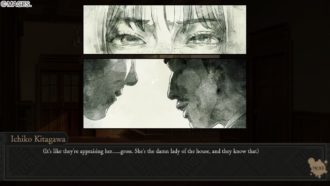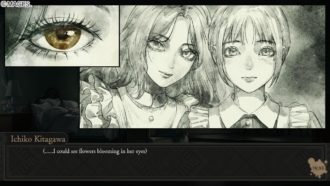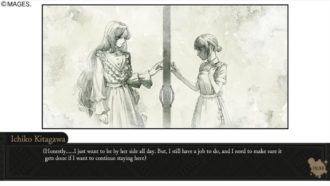Platforms:
PC, Nintendo Switch
Released:
August 15, 2025
Publisher:
PQUBE
Developer:
MAGES
When you’ve bled for someone, when you’ve really given all you have left, what else is there to do?
Iwakura Aria is a new visual novel from the creators of STEINS;GATE. Trading in the time travel and sci-fi themes for a horror period piece about romance and secrecy in a mansion in the ’60s, it’s quite a departure for the studio. What’s within is a story about love, power and sacrifice, concocted with painterly Renaissance-esque art and a bounty of quality of life features that you rarely find in the genre. Though it doesn’t always quite reach all of its ambitions, Iwakura Aria is an artful and memorable visual novel not to be missed.
We follow Ichiko, an orphan with a penchant for artistry, who quickly gets employed and housed by the illustrious Iwakura household, after the man of the house, Amane, takes a liking to her and her art. Hired as a maid, she’s to tend to the everyday duties of the household, and it’s here that she’s introduced and soon intertwined with the young Aria, Amane’s daughter. Across one fateful Summer, Ichiko forms a close connection with Aria and inadvertently finds herself in a lot of trouble as she slowly peels back the layers of mystery, intrigue, horror and secrecy that hide in the mansion’s halls.
The entire crux of the story is this connection between Ichiko and Aria, two girls of the same age, one born into wealth, one into poverty. Initially, Aria appears stand-offish to Ichiko no matter her efforts. Eventually, she lets down her guard and lets Ichiko in on her world, introducing her to a society and way of being entirely foreign to the orphan. We’re treated to little sweet moments as the two get to know each other better: stolen glances at crowded events hosted at the mansion, smiles and close bonding, days spent out in the sun in the property’s giant backyard garden.
It’s good, then, that this relationship between the pair is incredibly strong. Otherwise, the entire thing would fall apart. Aria and Ichiko are two young women who care about each other deeply, maybe even love each other, as much as two women could perhaps openly do at the time, given the 1960s Japan setting. The chemistry that they share is palpable, and though I’d hesitate to fully label Iwakura Aria as a Yuri game, as it doesn’t quite fully go there, the connection is more than enough to see you through the slow-burn story moments and other individual minor grievances you may have.
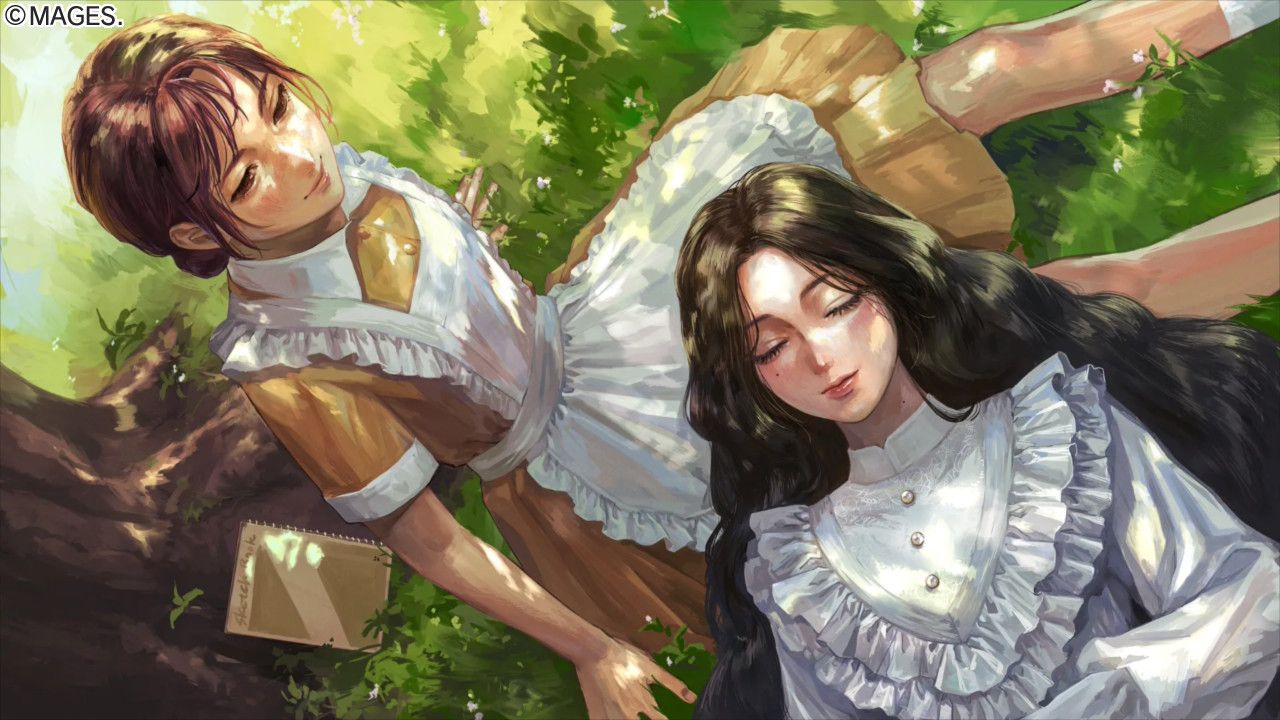
Iwakura Aria’s other key part to the story is the entire mystery it’s wrapped up in. Namely, what on Earth is going on with both Aria and the mansion? Aria is a figure of intrigue that you’re dying to know everything about immediately. She’s designed like an old Victorian doll with long jet black hair and piercing yellow eyes, in a flowy white dress. She’s frail and often has scarce energy, sleeping in til late in the afternoon and requiring a lot of care and attention. Something is going on with her, and the game gives you ample time to develop an investment in her before you find out her whole ordeal about halfway through its runtime.
“…a story about love, power and sacrifice, concocted with painterly renaissance-esque art”
Having this reveal situated here is a masterful decision by MAGES. Inc. It breaks the game down into two parts: one that keeps you on the edge of your seat and guessing what Aria is all about, and the latter that has you understanding and empathising with her. You, like Ichiko, are witnessing how the story and its events take a toll on Aria both physically and mentally, and you’re right there for the ride with the protagonist, desperate to find herself and you a way out of it.
On those possible escapes, or, well, endings, there are upwards of ten possible endings to find in Iwakura Aria. Some of these are abrupt endings when you’ve made a poor choice. Others are detailed and go on for several scenes, flashing forward and displaying how wildly different Ichiko and Aria’s lives can change due to a decision. I love the visual novel genre. What I don’t love about it is the endless chase for alternate endings to get the full picture, without some forewarning about when something is about to branch and offshoot. I can’t count the number of times this has led to me missing an ending or having to reload a save from hours ago due to a dead-end decision. Iwakura Aria rights this wrong in the genre by actively and automatically quick-saving before every decision. Gone are the frustrations, and I feel my inquisitive mind going down every possible path to see how things can play out, with it always rewarding me and never feeling like hard work.
I, of course, won’t spoil where the story goes, but what I will say is that Iwakura Aria did surprise me in many ways. Narrative beats I thought were obvious and plain as day were never exactly what they seemed, and had a lot more going for them upon gaining further context. Characters get more involved and delight you in other ways if you take the time to invest in seeing the other routes the game can take. I was obsessed and wanted to find every little detail.
These quality-of-life additions also extend to scripted moments when Ichiko can freely explore different rooms of the mansion, transporting her to scenes where she’s finding a curio or more backstory on another character. Across the game, Ichiko will sketch moments of interest in her sketchbook in pencil that you can revisit at any time. When you combine that with the in-game manual bursting with style, along with refined and slick HUD and menus, it certainly feels more like a premium visual novel experience that’s holistically rounded out, rather than just a stock standard ‘spamming a to continue’ title.
MAGES. Inc. obviously spared very little expense when it comes to the art for Iwakura Aria. Each character is portrayed in an oil-painting style where every little flourish or minor detail can spark awe and wonder. When the game eloquently describes Aria’s beauty and grace in everything she does and says, you’re witnessing it with your own eyes because of not just her character design, but how her sprite is illuminated and stands out in a scene. There’s a good amount of CGs to give you an ample glimpse of the main cast in their entirety and in different contexts; whether it’s a scene where they’re joyous or one more drenched in suspense or horror. In more intense scenes, you’re often again witnessing hand-drawn scenes in detailed pencil, freshening up what the player is seeing and therefore grabbing the player’s attention following low-key moments.
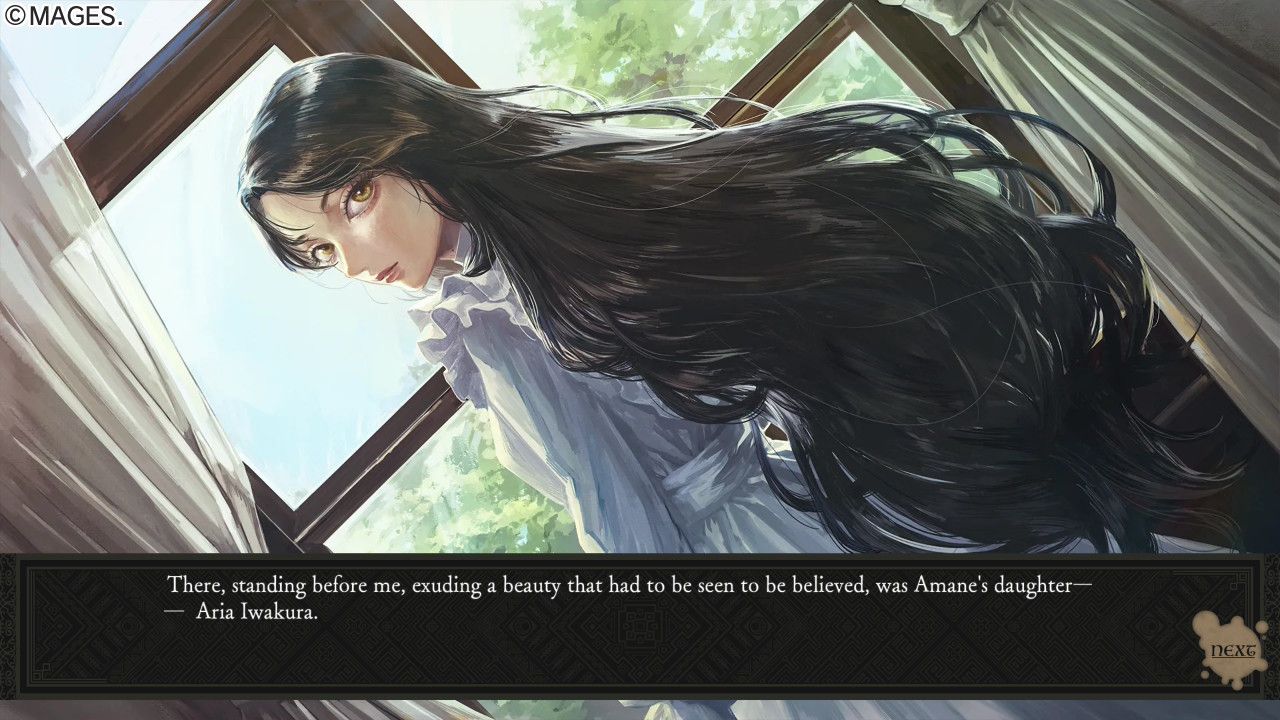
Where Iwakura Aria’s art could be improved only somewhat is in the number of sprites. There are essentially four main characters: Ichiko, Aria, Amane and Chef Sui, Ichiko’s other main confidant. There are, however, more characters in the game, and though they’re not exactly main cast, they’re recurring and important enough to the story that I found myself begging them to get a sprite or detailing to no avail. It’s enough to momentarily take you out of the story. The most noticeable example of this is a mysterious gardener that both Ichiko and Aria note wandering the grounds, appearing odd. At one moment, he provides key information to the story that helps contextualise a lot of questions you’ve been having. While this occurs, you never see what he looks like, pressing ‘A’ to proceed through a series of text boxes against a single shot of the backyard. Infuriating.
Iwakura Aria is filled with utterly enchanting prose. As a queer woman myself, it’s awe-inspiring to read the ways that the game depicts and details a young woman very clearly having a lot of feelings for another woman. It paints what it’s like to find love in the most unexpected of places and how that can change someone. It illuminates the player as to how cut of a different cloth queer love can be—how you’d stop at nothing to form your entire world around that one special person. Even in years of highlighting queer writing in games, Iwakura Aria surprised me. It’s got something different going for it that I was lapping up every inch of.
9
Amazing
Positive:
- Breathtaking and painterly art that details the beauty and horror within the story
- Page-turner of a narrative that surprises the player
- Ichiko and Aria's chemistry is superb
- Engaging alternate endings that aren't a pain to unsurface
Negative:
- Some characters lack sprites, occasionally taking you out of the story
MAGES. Inc. delivered and then some with Iwakura Aria. What’s within is an electric and rich visual novel story, a page-turner that is filled to the brim with memorable and beautiful prose as it expertly weaves its themes. Better yet, it sands off all the rough edges of the genre with quality-of-life improvements. Where there’s sacrifice and power found within the halls of the Iwakura mansion, there’s also love, adoration and devotion. Whether it’s in protagonist Ichiko’s investment in the illustrious Aria or the player following along at every beat, you’re both in for an artful and magnificent ride.

